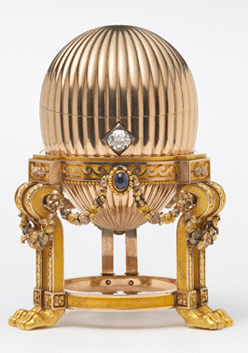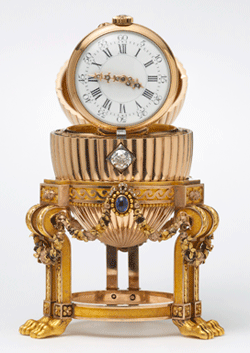|
Since Fabergé Eggs were highlighted previously in this column, this news is doubly worthy of note. One the 50 Imperial Fabergé Eggs created for Tsar Nicholas II to give as an Easter present to Tsarina Maria Feodorovna was purchased at a flea market by a Mid-western scrap metal dealer for about $13,000. The unidentified buyer bought it initially for the value of its gold and diamonds, but he held onto it for some time, not knowing its true nature but suspecting that it had greater value.
|

|

|
|
The $33 million Faberge Egg that was
purchased for about $13,000.
|
A pop-up Vacheron Constantin clock is the surprise when the egg opens.
(Both images copyright © Wartski, 2014. Photography by Prudence Cuming Associates.)
|
After the Russian Revolution, many Fabergé Eggs were sold to collectors in the West, which is how this one turned up here. It was last recorded as being sold in 1964 at an auction in New York for $2,450. There, it was listed as a “Gold watch in egg form case.”
What about a maker’s mark? Yes, the mark of Fabergé’s Chief-Jeweler August Holmström is on the egg, but no one recognized it. Holmström created the egg in St. Petersburg between 1886 and 1887.
After searching on the Internet, the scrap metal dealer contacted Wartski, the Royal Warrant-holders of Fabergé based in London. Wartski verified it as an Imperial Faberge Egg and arranged for its sale to a private collector for a reported $33 million.
The egg, which was the third made by Faberge for Tsar Nicholas, contains a Vacheron Constantin clock that pops up as the surprise. The egg measures 8.2 cm in height, and it is supported on a sabléd gold stand with lion paw feet and is encircled by finely chased gold garlands suspended from three cabochon blue sapphires topped with a rose diamond set.
Wartski reports two of eight missing Imperial Eggs are known to still exist: the 1889 Necessaire Egg with chased gold, pearls, gemstones, 13 miniature toilet articles and no stand, last seen in June of 1952; and the 1888 Cherub Egg with Chariot, last possessed by Armand Hammer in 1934.
|